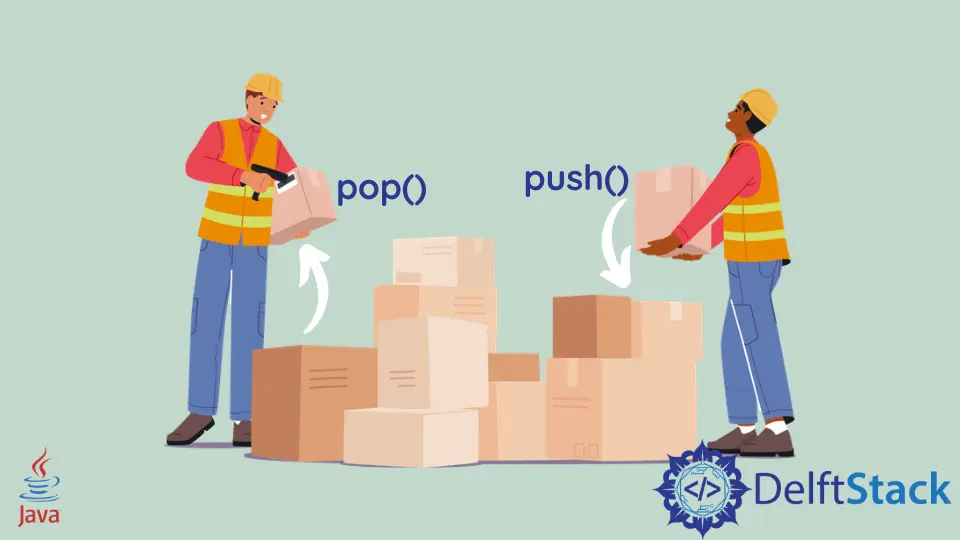Java 中的堆栈 pop 和 push 方法
Rupam Yadav
2023年10月12日

push 操作将一个元素添加到堆栈的最顶部位置,而 pop 操作删除堆栈的最顶部元素。
我们将在下面的部分中介绍如何将堆栈的概念与 push 和 pop 操作一起使用。
在 Java 中使用 ArrayList 使用 Push Pop 堆栈
以下示例使用 ArrayList 来实现堆栈。首先,我们创建两个类,一个是 ExampleClass1,另一个是 StackPushPopExample,我们在其中创建了堆栈中的 push 和 pop 操作的逻辑。
push()方法:采用int参数类型并将其添加到我们创建的列表的第一个位置。堆栈遵循后进先出的 LIFO 概念,将每个新项目添加到第一个位置并移动旧项目。pop()函数:首先检查堆栈是否为空,如果不是,则继续删除列表第零索引处的元素或堆栈的最顶部元素。
例子:
import java.util.ArrayList;
import java.util.List;
public class ExampleClass1 {
public static void main(String[] args) {
StackPushPopExample stackPushPopExample = new StackPushPopExample(5);
stackPushPopExample.push(2);
stackPushPopExample.push(3);
stackPushPopExample.push(4);
stackPushPopExample.push(7);
stackPushPopExample.push(1);
System.out.println("Topmost Element of the stack: " + stackPushPopExample.peek());
System.out.println("All Stack Items:");
for (Integer allItem : stackPushPopExample.getAllItems()) {
System.out.println(allItem);
}
stackPushPopExample.pop();
System.out.println("All Stack Items After popping one item:");
for (Integer allItem : stackPushPopExample.getAllItems()) {
System.out.println(allItem);
}
}
}
class StackPushPopExample {
private final List<Integer> intStack;
public StackPushPopExample(int stackSize) {
intStack = new ArrayList<>(stackSize);
}
public void push(int item) {
intStack.add(0, item);
}
public int pop() {
if (!intStack.isEmpty()) {
int item = intStack.get(0);
intStack.remove(0);
return item;
} else {
return -1;
}
}
public int peek() {
if (!intStack.isEmpty()) {
return intStack.get(0);
} else {
return -1;
}
}
public List<Integer> getAllItems() {
return intStack;
}
}
输出:
Topmost Element of the stack:: 1
All Stack Items:
1
7
4
3
2
All Stack Items After popping one item:
7
4
3
2
为了查看堆栈中的元素,我们创建了两个函数,返回堆栈顶部项目的 peek() 方法和返回堆栈中所有项目的 getAllItems() 方法。
最后,pop() 函数删除堆栈的第一个元素,然后再次打印堆栈以查看该元素是否被删除。
使用 Java 中的 Stack 类使用 Push Pop 堆栈
Java 中的集合框架提供了一个名为 Stack 的类,它为我们提供了在堆栈中执行所有基本操作的方法。在下面的代码片段中,我们将创建一个类型参数为 String 的 Stack 对象。
例子:
import java.util.Stack;
public class ExampleClass1 {
public static void main(String[] args) {
Stack<String> stack = new Stack<>();
stack.push("Item 1");
stack.push("Item 2");
stack.push("Item 3");
stack.push("Item 4");
stack.push("Item 5");
System.out.println("Topmost Element of the stack: " + stack.peek());
stack.pop();
System.out.println("After popping one item:");
System.out.println("Topmost Element of the stack: " + stack.peek());
}
}
输出:
Topmost Element of the stack: Item 5
After popping one item:
Topmost Element of the stack: Item 4
要将元素添加到堆栈中,我们调用 push() 方法,要打印堆栈的第一个元素,我们调用 peek() 函数。
然后我们使用 pop() 方法删除顶部项目,然后我们再次调用 peek() 方法来检查 pop() 方法是否删除了顶部项目。
与上一个示例相比,此方法的好处是执行相同操作所需的代码更少。
作者: Rupam Yadav
Rupam Saini is an android developer, who also works sometimes as a web developer., He likes to read books and write about various things.
LinkedIn